L-R: Ching Neng Bin, Lim Peng Peng, Gan Choi Geok, See Beow Aun, Lee Kam Boon, Cindy Chong, Chan Meng Fye, Choo Chiew Chin, Bernard Lee, Chew Leng Soon at a large book singing praises of the benefits of the Three Gorges Dam lookout point.
Backpacking 26 days through 6 provinces in China Sichuan, Chongqing, Hubei, Hunan, Guizhou, Guangxi and 3 days in Hanoi, North Vietnam (29 Mar - 26 Apr 2011).
Day 8 (05.04.2011) Yangtze River Cruise day 1 of 3
Morning was walking along the Yangtze River market and later bought sundries for the 3day 650km river cruise to Yichang. Pick-up from hostel at 3.30pm by van to another pickup point. From here a big bus took us to the port city of Wenzhou along the mighty Yangtze River. At Wenzhou we got on the cruise boat at 7.30pm. We then had late dinner at 9pm on board MV Yun Chun Cruise boat. At about 11pm, we visited the famous Zhangfei Temple (optional Y40) for an hour. Stayed overnight on the boat.
Hubei is a landlocked province in Central China. Its varied terrain encompasses mountains, lakes and wilderness areas. Wuhan, its capital, is the site of picturesque East Lake, the 5-tiered Yellow Crane Tower and the vast Hubei Provincial Museum. The province is also known for the Three Gorges, a popular destination for Yangtze River cruises and home to the massive Three Gorges Dam.
Hubei is a landlocked province in Central China. Its varied terrain encompasses mountains, lakes and wilderness areas. Wuhan, its capital, is the site of picturesque East Lake, the 5-tiered Yellow Crane Tower and the vast Hubei Provincial Museum. The province is also known for the Three Gorges, a popular destination for Yangtze River cruises and home to the massive Three Gorges Dam.

Ching Neng Bin admiring the big-bike in Chongqing City.

On the narrow streets and hilly terrain of the Yangtze River that allows these porters to make a living.

A road side medical practitioner in Chongqing City.

Morning was walking along the Yangtze River market and later bought sundries for the 3day 650km Yangtze River cruise.

Baby eels for sale in Chongqing market.

Rabbit meat for sale in Chongqing market.

The road side market in Chongqing City.

A very strong looking old lady taking her breakfast in Chongqing City market.

Another very strong looking old lady in Chongqing City market.

Bernard Lee and Ching Neng Bin bought sundries from a super-mart for the 3day 650km Yangtze River cruise.

Pick-up from hostel at 3.30pm by van to another pickup point. From here a big bus took us to port city of Wenzhou along the mighty Yangtze River.

The big bus took us to port city of Wenzhou along the mighty Yangtze River.

Crossing the mighty Yangtze River in Chongqing City.

The Chongqing City view from the mighty Yangtze River.

The Chongqing City view from the mighty Yangtze River.

At port city of Wenzhou pier along the mighty Yangtze River we got on the cruise boat at 7.30pm to the Three Gorges Dam.

The Port of Wenzhou is a natural estuary deep-water international seaport on the coast of Wenzhou.

At port city of Wenzhou pier for the 3day 650km Yangtze River cruise by MV Yun Chun to Three Gorges Dam.

This is the MV Yun Chun 4-pax cabin and Bernard Lee with Ching Neng Bin on the top bunk.

A night view of Wanzhou City from MV Yun Chun cruise boat along the mighty Yangtze River.

A night view of Wanzhou City from MV Yun Chun cruise boat along the mighty Yangtze River.

We had late dinner at 9pm on board MV Yun Chun Cruise boat. At about 11.30pm, we visited the famous Zhangfei Temple (optional Y40) for an hour. Stayed overnight on the boat.

At 11.30pm before we could close our eyes, a voice over the PA announcing that we have arrived at our first visit to the Zhangfei Temple along the mighty Yangtze River, 82km from Chongqing City.

The Zhang Fei Temple sat on the Flying Phoenix hillside on southern bank of River Yangtze from Yunyang County in Chongqing. The temple was built in honor of General Zhang Fei, a Second Century AD military leader of the Three Kingdoms Period.

A scene depicting the court of ancient times in Zhangfei Temple along the mighty Yangtze River.

The skyline of Zhangfei Temple along the mighty Yangtze River in Yunyang County.

The skyline of Zhangfei Temple along the mighty Yangtze River in Yunyang County.

The enormous Zhangfei Temple hall has a colossal statue of Zhang Fei.

Returning to MV Yun Chun Cruise boat at 12.30am to get some sleep.

Ching Neng Bin returned to MV Yun Chun Cruise boat at 12.30am to get some sleep.

Lee Kam Boon returned to MV Yun Chun Cruise boat at 12.30am to get some sleep.

Chew Leng Soon returned to MV Yun Chun Cruise boat at 12.30am to get some sleep.
Day 9 (06.04.2011) Yangtze River Cruise day 2 of 3
We woke up at 6am for breakfast. From 7am to 9am we visited the White King Town or Baidi City (optional Y90) at Fengjie County. From 12 noon to 5pm we visited the Small or Lesser Three Gorges in Wushan (included Y190). We had to get into a tourist boat to go upstream. We returned to our cruise boat at 5.45pm. However, the Yun Chun Cruise boat continued with the journey at 6.15pm. Stayed overnight on the boat.
"White King Town" is located on the northern bank of the Yangtze River and stands at the entrance to Qutang Gorge. The Ba Kingdom began here over 2,000 years ago and according to the legend, Gongsun Shu started to build the town and came across a well. There was a white vapor that came out of the well that he regarded as a flying white dragon. This is where the name of the town came from.
"Small or Lesser Three Gorges" with an area of 160 hectares of forest, lies on the lower reaches of Daning, extending from the entrance of the Dragon-Gate Gorge in the South to Tujiaba in the North for 50km. Here sheer cliffs and steep mountains rise on either side, creating one of natural fine arts gallery as natural scenic wonders unfold on both banks of the river. Clear water flows between precarious precipices and peaks covered with green trees and bushes.
"White King Town" is located on the northern bank of the Yangtze River and stands at the entrance to Qutang Gorge. The Ba Kingdom began here over 2,000 years ago and according to the legend, Gongsun Shu started to build the town and came across a well. There was a white vapor that came out of the well that he regarded as a flying white dragon. This is where the name of the town came from.
"Small or Lesser Three Gorges" with an area of 160 hectares of forest, lies on the lower reaches of Daning, extending from the entrance of the Dragon-Gate Gorge in the South to Tujiaba in the North for 50km. Here sheer cliffs and steep mountains rise on either side, creating one of natural fine arts gallery as natural scenic wonders unfold on both banks of the river. Clear water flows between precarious precipices and peaks covered with green trees and bushes.

We disembarked from MV Yun Chun Cruise boat at Fengjie County to visit the White King Town or Baidi City.

The tram on the right offers alternative to climbing the steps at Fengjie County to visit the White King Town.

A flotilla of tourist boats at Fengjie County on the bank of the Yangtze River.

The cruise ship berthed on the right hand shore of the river and after walking through a small area selling souvenirs and fresh fish we took a short 5 min bus to the bridge at the entrance of the site. At Fengjie County on the bank of the Yangtze River.

The long highly decorated wooden bridge on the Yangtze River to White King's City island at Fengjie County.

The long highly decorated wooden bridge on the Yangtze River to White King's City island at Fengjie County.

The long highly decorated wooden bridge on the Yangtze River to White King's City island at Fengjie County.

At the wooden bridge entrance on the Yangtze River to White King's City island at Fengjie County.

The long wooden bridge walk to White King's City island or Baidi City at Fengjie County.

The long wooden bridge walk to White King's City island or Baidi City at Fengjie County.

From the bridge there is a 346 step hill climb to White King's City or Baidi City at Fengjie County. From the top of the hill temple are magnificent views of the Yangtze river looking upstream. However, the downstream view is simply stunning as you are looking directly at the Kui Gate which marks the entrance of the Yangtze river as it flows into the Qutang Gorge. This view is depicted on the back of a 10 yuan note. An another hill to the left of the Kui gate is an old fortress guarding the strategic importance of the Kui Gate and the entrance to the Qutang Gorge, you can still see the canons which guarded the entrance from the Japanese during WWII.

This Qutang Gorge crossing is famous for the Battle of Red Cliffs. The Qutang Gorge is only 8km long, but it is also the narrowest of the Three Gorges. The widest point measures only 150 metres (500 ft) wide. The mountains on either side reach as high as 1,200 metres (4,000 ft). This combination of narrow canyons among high mountains with several switchbacks in only 8km creates spectacular vistas, and the Qutang Gorge is often considered the most beautiful of all the Three Gorges.

Horse service is available for those who can't do the 346 step hill climb to White King's City or Baidi City.

The temple consists of many buildings, gardens and ornate water features. Many of the buildings have ornate replica statues which help to explain the history behind the White Emperor and Temple / City itself. The Ba Kingdom began here over 2,000 years ago.

The entrance inscribed with White King's City.

The scene depicting the King on his death bed appointing his successor at White King's City.

Tuogu Hall (托孤堂) or Entrusting Orphan Hall is the most attractive place at White Emperor City. There you could see the vivid imitating scene of Liu Bei entrusting his son and whole country to his prime minister Zhuge Liang. The history has it that Liu Bei, the first king of the Shu Kingdom was defeated by the Wu Kingdome and retreated to White Emperor City. Since he became ill severely but his son named Liu Chan was too young to take over the state, he eagerly called Zhuge Liang to Baidi Cheng and entrusted Liu Chan and the whole country to Zhuge before his death. Later Zhuge didn’t rule the country as his own but educated and assisted Liu Chan sincerely, hoping his taking charge of the whole country from his father. That touching and famous story was told by generations of people and Zhuge Liang is always reputed with his loyalty and integrity.

On the bus back to the cruise ship wondering what the people doing work on the road.

Another large cruise ship berthed on the shore of the river.

A window view from MV Yun Chun Cruise boat cabin.
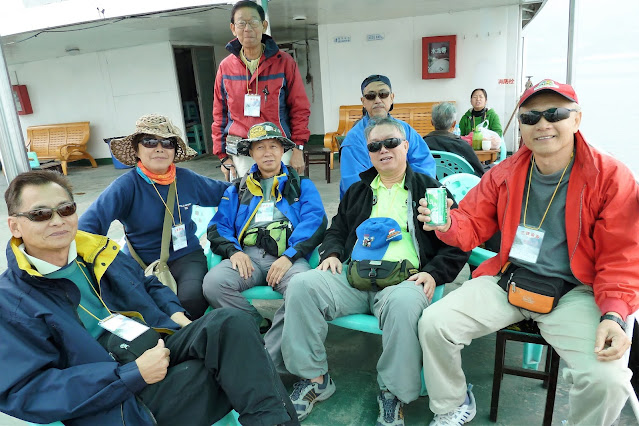
Taking a beer and relaxing on deck after returning from White King's City.

The Chalk Wall (粉筆牆) is a white cliff face on the southern bank of the Yangtze River at the entrance to the Qutang Gorge (Kuimen Gate).
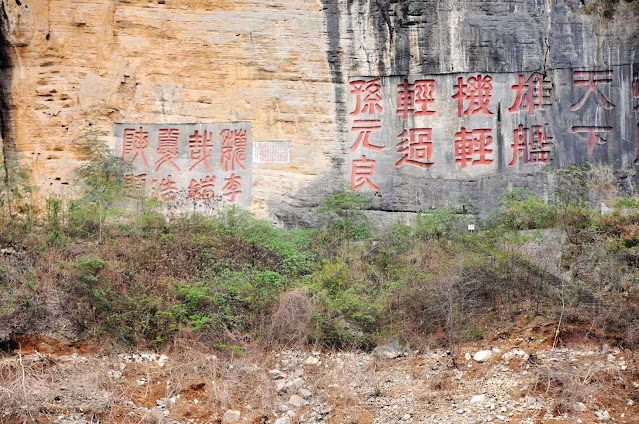
The Chalk Wall has numerous characters carved into the rock, many of which were done by famous Chinese calligraphers. Nearly 1,000 characters in all are carved into the rock wall, with the oldest dating to the Song Dynasty (960-1279). The wall has characters carved in many different styles of calligraphy and in various sizes. The largest characters are approximately 1.7 metres (6 ft) wide.

Everybody is admiring the Chalk Wall (粉筆牆) a white cliff face on the southern bank of the Yangtze River.

The Chalk Wall (粉筆牆) a white cliff face on the southern bank of the Yangtze River.

Passing through the Three Gorges.

Another large cruise ship on the the Yangtze River.

Drinking beer and relaxing on deck MV Yun Chun Cruise boat.

Another large cruise ship on the the Yangtze River.

Another large cruise ship MV Empress on the the Yangtze River.

From 12 noon to 5pm we visited the Small Three Gorges in Wushan. We had to get into this tourist boat to go upstream.

From 12 noon to 5pm we visited the Small Three Gorges in Wushan. We had to get into this tourist boat to go upstream.

Another large cruise ship on the the Yangtze River.

We were transferred onto smaller boat up the Lesser Three Gorges.

We were transferred onto smaller boat passing through the Lesser Three Gorges.

"Small or Lesser Three Gorges" with an area of 160 hectares of forest, lies on the lower reaches of Daning, extending from the entrance of the Dragon-Gate Gorge in the South to Tujiaba in the North for 50km. Here sheer cliffs and steep mountains rise on either side, creating one of natural fine arts gallery as natural scenic wonders unfold on both banks of the river. Clear water flows between precarious precipices and peaks covered with green trees and bushes.

The plank-walk way on the cliffs running along the river of Lesser Three Gorges.

The plank-walk way on the cliffs running along the river of Lesser Three Gorges.
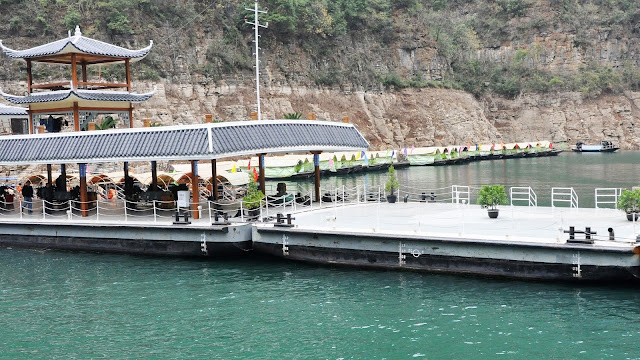
Here we boarded a small boat to enjoy the spectacular views and experience a water-borne sensation. Its "subtle mountains, clear waters, pretty rocks, dangerous rapids, sharp turns, fantastic caves, and stalactites in various shapes" characterize the natural landscape in the Small Three Gorges. A number of historical places of interest along the way, such as suspending coffin, boat coffin, remains of ancient plank walkway.
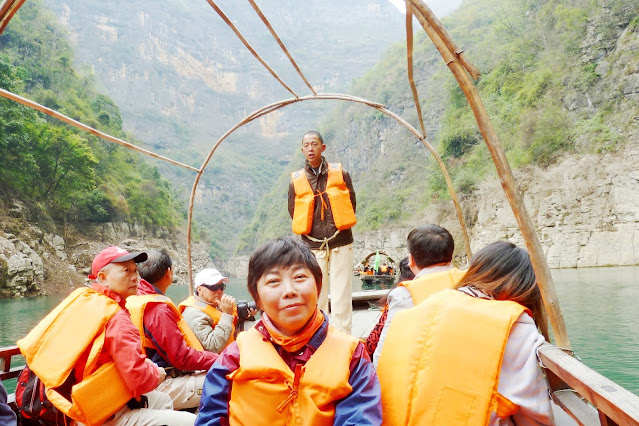
We were onto small boat up the narrow river with sheer cliffs and steep mountains rise on either side.

We were onto small boat up the narrow river with sheer cliffs and steep mountains rise on either side.

People singing and playing instrument on the cliff surface along the river.

We were listening to people singing and playing instrument on the cliff surface along the river.

Gan Choi Geok dressed as local fisherman in the small boat.

Lee Kam Boon dressed as local fisherman in the small boat.

Ching Neng Bin dressed as local fisherman in the small boat.

Hanging coffins are placed in caves in the face of cliffs, or sit on natural rock projections on mountain faces.

Hanging coffins are a method of ceremonially placing the corpses of the deceased upon cliff sides, an ancient funeral custom of some minority groups, especially the Bo people of southern China. Coffins of various significant shapes were often carved out of a whole piece of wood.

We returned to our cruise boat at 5.45pm. However, MV Yun Chun Cruise boat continued with the journey at 6.15pm.

Back to our MV Yun Chun Cruise boat, the guide was talking about the various rock formation resembling this and that - you have to stretch your imagination to see the resemblance.

The natural landscape in the Small Three Gorges of the Yangtze River.

A serene Yangtze River.sunset view on deck MV Yun Chun Cruise boat.

Gan Choi Geok getting ready to sleep in MV Yun Chun Cruise boat.
Day 10 (07.04.2011) Yangtze River Cruise day 3
We woke up at 6am for breakfast. From 7 to 9am we visited the Jiuwan River Scenic Area on smaller boat. At 2pm we arrived at the small town of Maoping and got off the cruise boat. From Maoping to Xiling by tourist bus to visit the 3 Gorges Dam and by the same bus to Yichang arriving at 5.30pm. Jiuwan Stream (九畹溪) is situated at south bank of Xiling Gorge (西陵峡), west of the new county of Zigui (秭归), 20km away from the Three Gorges Dam (三峡大坝). With the length of 42.3km, it covers the area of 514.5 square kilometers. The average depth of the Jiuwan Stream is 0.8 meters, and the width of it ranges from 40 to 710 meters. It is sparely populated at the bank of the Jiuwan Stream, and the environment is very pleasant. It was once the place where the great patriotic poet Qu Yuan (屈原) used to give lectures and planted orchid. The Jiuwan Stream Scenic Area is famous for its fancy mountains, clear water, glanderous cliffs, odd stones and famous flowers. It is the top scenic area in Three Gorges Dam which offers exploration, relaxation and sightseeing.
An agent who bought the middle sleeping berth train ticket (normal Y59 but we were charged Y100) which included transport from Yichang Port to restaurant in town for dinner and then to train station for train to Zhangjiajie). At 12.25am train left Yichang to Zhangjiajie. Sleeping – overnight train.

The big drums to welcome us for the visit to Jiuwan River Scenic Area on another boat.

The big drums to welcome us for the visit to Jiuwan River Scenic Area on another boat.

We were taken onto long dragon boat up the Jiuwan River Scenic Area.

We end up at a jetty where we walked up the mountain to view the Jiuwan River Scenic landscape.

The interesting material for the wobbly pontoon bridge at Jiuwan River Scenic Area.

The high wire acrobatic performance for us to view at Jiuwan River Scenic Area.

The high wire acrobatic performance for us to view at Jiuwan River Scenic Area.

The steep steps up the mountain side to view Jiuwan River Scenic Area.

The aerial view of the pontoon bridge at Jiuwan River Scenic Area.
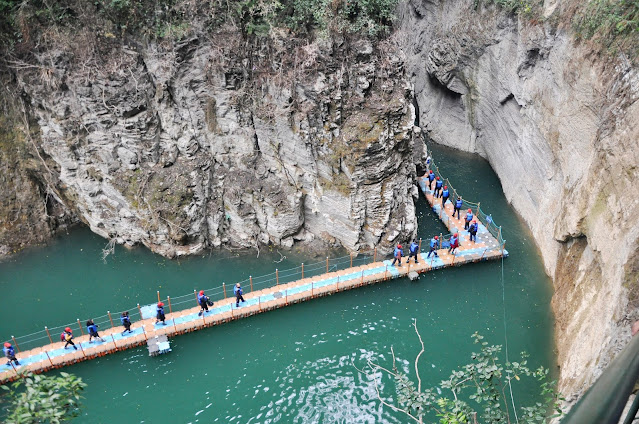
The aerial view of the pontoon bridge at Jiuwan River Scenic Area.

The end of the long mountain walk and back to the Jiuwan Stream boat jetty for the local dance performance.

Gan Choi Geok had a whole fish for lunch at Jiuwan Stream boat jetty.

Taking the long dragon boat back to our cruise boat for Maoping Port.

Our cruise ended and passengers prepared to check out and disembark in Maoping Port to take a bus to visit famous Three Gorges Dam site.

Taking the bus at Maoping to Xiling for the famous Three Gorges Dam site.

Visited one of the flooded ship locks to allow boats to pass through the Three Gorges Dam.

Visited one of the flooded ship locks to allow boats to pass through the Three Gorges Dam.

At the lookout point for the whole Three Gorges Dam area beside the museum.

L-R: Gan Choi Geok, Lim Peng Peng, Cindy Chong, See Beow Aun, Chan Meng Fye, Bernard Lee, Ching Neng Bin at the Three Gorges Dam lookout point.

Malaysian backpackers at a large book singing praises of the benefits of the Three Gorges Dam lookout point.

Ching Neng Bin at a large book singing praises of the benefits of the Three Gorges Dam lookout point.

A good view of the Three Gorges Dam from lookout point.
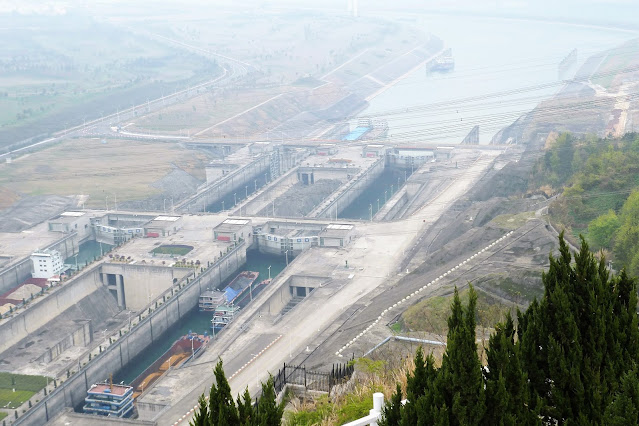
A good view of the flooded ship locks from Three Gorges Dam lookout point.

Lee Kam Boon at the gigantic equipment on display at the Three Gorges Dam museum park.

Lee Kam Boon at the gigantic equipment on display at the Three Gorges Dam museum park.

The cherry blossoms in abundance at the Three Gorges Dam museum park.

Nice local biscuits at the Three Gorges Dam museum park.

At Yichang train station waiting for 12.25am train to Zhangjiajie.

At Yichang train station waiting for 12.25am train to Zhangjiajie.
Total expenses in China to-date is RM1,584 per person. End of part 3.
China Part 2 (day 06-07) Chongqing Province
China Part 3 (day 08-10) Hubei Province
China Part 4 (day 11-15) Hunan Province
China Part 5 (day 16-18) Guizhou Province
China Part 6 (day 19-25) Guangxi Province
China Part 7 (day 26-29) Hanoi, Vietnam
///Backpacking Adventure



We're a bunch of volunteers and starting a brand new scheme in our community. Your site provided us with valuable information to work on. You have done a formidable job and our entire community will be grateful to you.
ReplyDeleteAlso visit my weblog :: Tropical Holidays